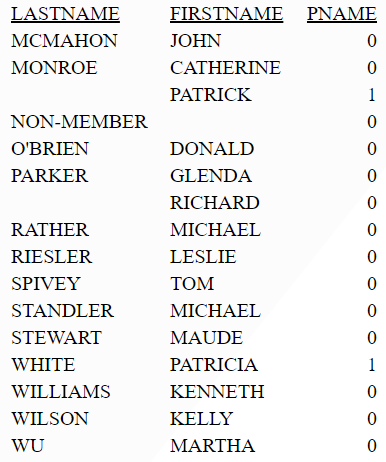Syntax: How to Match a String to a Regular Expression
REGEX(string, regular_expression)
where:
- string
-
Alphanumeric
Is the character string to match.
- regular_expression
-
Alphanumeric
Is a regular expression, enclosed in single quotation marks, constructed using literals and meta-characters. The following meta-characters are supported
- . represents any single character
- * represents zero or more occurrences
- + represents one or more occurrences
- ? represents zero or one occurrence
- ^ represents beginning of line
- $ represents end of line
- [] represents any one character in the set listed within the brackets
- [^] represents any one character not in the set listed within the brackets
- | represents the Or operator
- \ is the Escape Special Character
- () contains a character sequence
For example, the regular expression '^Ste(v|ph)en$' matches values starting with Ste followed by either ph or v, and ending with en.
Note: The output value is numeric.
Example: Matching a String Against a Regular Expression
The following request matches the FIRSTNAME field against the regular expression 'PATRIC[(I?)K]', which matches PATRICIA or PATRICK:
DEFINE FILE VIDEOTRK PNAME/I5=REGEX(FIRSTNAME,'PATRIC[(I?)K]'); END TABLE FILE VIDEOTRK PRINT FIRSTNAME PNAME BY LASTNAME WHERE LASTNAME GE 'M' ON TABLE SET PAGE NOLEAD ON TABLE SET STYLE * GRID=OFF,$ ENDSTYLE END
The output is shown in the following image.

The following version of the request runs on z/OS. The variable ®1 contains the regular expression string with the circumflex character (^) inserted as CHAR(95), the left bracket character ([) inserted as CHAR(173), and the right bracket character (]) inserted as CHAR(189). The other meta-characters are interpreted correctly.
-SET ®1 = CHAR(95) || 'PATRIC' || CHAR(173) || - '(I?)K' || CHAR(189); DEFINE FILE VIDEOTRK PNAME/I5 = REGEX(FIRSTNAME,'®1') ; END TABLE FILE VIDEOTRK PRINT FIRSTNAME PNAME BY LASTNAME WHERE LASTNAME GE 'M' ON TABLE SET PAGE NOLEAD END
The output follows.
LASTNAME FIRSTNAME PNAME
-------- --------- -----
MCMAHON JOHN 0
MONROE CATHERINE 0
PATRICK 1
NON-MEMBER 0
O'BRIEN DONALD 0
PARKER GLENDA 0
RICHARD 0
RATHER MICHAEL 0
RIESLER LESLIE 0
SPIVEY TOM 0
STANDLER MICHAEL 0
STEWART MAUDE 0
WHITE PATRICIA 1
WILLIAMS KENNETH 0
WILSON KELLY 0
WU MARTHA 0